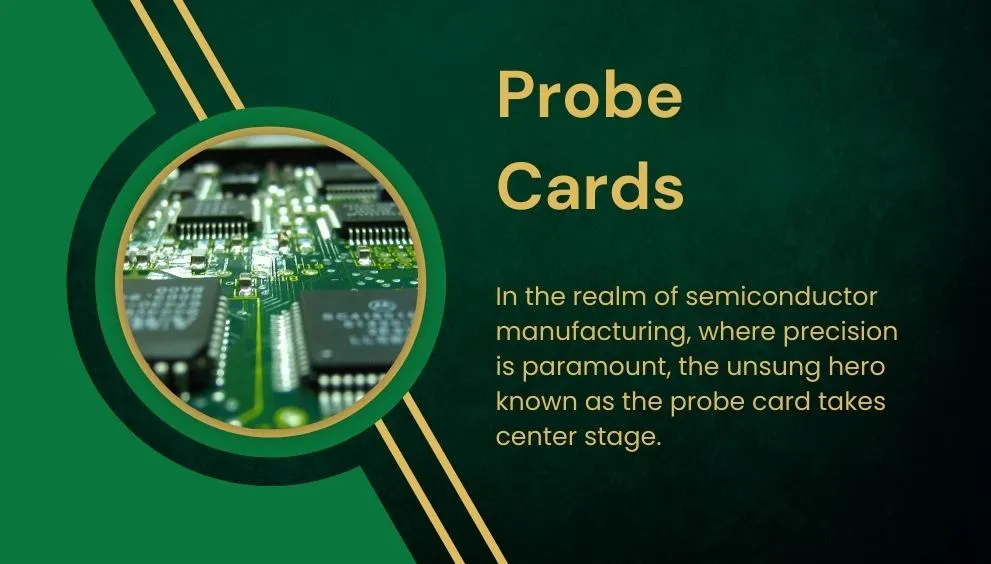Probe Card: A Comprehensive Study On Growth

In the realm of semiconductor manufacturing, where precision is paramount, the unsung hero known as the probe card takes center stage. This comprehensive guide invites you into the intricate world of probe cards, exploring their role in semiconductor testing, the evolution of testing methodologies, and the pivotal role they play in ensuring the functionality and reliability of the microchips that power our digital landscape.
Introduction to Probe Card: The Gatekeepers of Semiconductor Quality
The Heart of Semiconductor Testing
- Role in IC Testing: A fundamental overview of the critical role probe cards play in testing integrated circuits (ICs), ensuring each component meets the stringent standards of functionality and reliability.
- Link to Yield Enhancement: Understanding how probe cards contribute to yield enhancement by identifying and rectifying defects early in the semiconductor manufacturing process.
Evolution of Semiconductor Testing
- Historical Perspectives: Tracing the evolution of semiconductor testing methodologies and the pivotal role probe cards have played in advancing the efficiency and accuracy of the testing process.
- From Wafer-Level to Die-Level Testing: Exploring the transition from wafer-level testing to die-level testing and the implications for semiconductor manufacturers in terms of quality control and production scalability.
Anatomy of a Probe Card: Decoding the Components
Microscopic Precision
- Needle or Cantilever: A detailed examination of the microscopic components of a probe card, including the needle or cantilever responsible for making contact with the semiconductor device under test (DUT).
- Materials and Manufacturing: Insights into the materials used in probe card construction and the intricacies of the manufacturing process, highlighting the importance of precision and durability.
Multiple Technologies, One Goal
- Wire Bonding vs. Flip Chip Technology: A comparative analysis of wire bonding and flip chip technologies in probe card design, exploring the advantages and limitations of each approach.
- Microfabrication Techniques: An exploration of advanced microfabrication techniques employed in the creation of intricate probe card structures, emphasizing the need for sub-micron accuracy.
Types of Probe Cards: Tailoring Solutions for Diverse Needs
Cantilever Probe Cards
- Spring-Loaded Precision: Delving into the mechanics of cantilever probe cards, which utilize spring-loaded needles to establish contact with semiconductor devices for testing.
- Applications in Mass Production: The suitability of cantilever probe cards for mass production environments, where rapid and accurate testing is imperative.
Vertical and MEMS Probe Cards
- Micro-Electro-Mechanical Systems (MEMS): Exploring the use of MEMS technology in probe cards, allowing for increased precision and adaptability to diverse testing scenarios.
- Vertical Probe Card Advancements: An examination of vertical probe card technologies, which offer advantages in terms of reduced probing force and improved signal integrity.
Advanced Probe Card Configurations
- Multi-DUT Testing: The capabilities of advanced probe card configurations that facilitate testing of multiple devices simultaneously, increasing throughput and efficiency.
- High-Frequency and RF Probe Cards: Specialized probe card configurations designed for testing high-frequency and radio frequency (RF) semiconductor devices, ensuring accuracy in communication applications.
Applications Across the Semiconductor Landscape: From Foundries to Packaging
Semiconductor Foundries
- Wafer-Level Testing: The crucial role of probe cards in wafer-level testing within semiconductor foundries, where early defect detection is paramount for maintaining high yields.
- Advanced Packaging: How probe cards contribute to the testing of advanced packaging technologies, including system-in-package (SiP) and 2.5D/3D packaging.
Memory and Logic Devices
- DRAM and NAND Flash Testing: The specific requirements and challenges in testing dynamic random-access memory (DRAM) and NAND flash memory devices, and how probe cards address these challenges.
- Logic IC Testing: The diverse applications of probe cards in testing logic ICs, ensuring the functionality and reliability of complex semiconductor devices.
Overcoming Challenges: Navigating the Road to Precision
Yield Management
- Defect Detection and Classification: Strategies employed by probe cards in defect detection and classification, contributing to yield management and the production of high-quality semiconductor devices.
- Real-Time Monitoring: The role of real-time monitoring in yield management, allowing semiconductor manufacturers to proactively address issues during the testing process.
Probing at Nanoscale
- Challenges in Nanoscale Testing: Addressing the unique challenges posed by nanoscale testing and how probe cards are adapted to handle the intricacies of modern semiconductor devices.
- Advancements in Nanoprobing Technology: Innovations in nanoprobing technology, enabling precise testing and analysis at the nanoscale level.
Innovations and Future Trends: Paving the Way for Tomorrow’s Semiconductor Landscape
Advanced Materials and Coatings
- Enhanced Durability and Conductivity: The role of advanced materials and coatings in enhancing the durability and conductivity of probe cards, leading to more robust and efficient testing.
- Reducing Wear and Tear: Innovations aimed at minimizing wear and tear on probe card components, increasing their lifespan and reliability.
Artificial Intelligence in Testing
- Data Analysis and Pattern Recognition: The integration of artificial intelligence (AI) in probe card testing, enabling advanced data analysis and pattern recognition for more efficient defect identification.
- Predictive Maintenance: Utilizing AI for predictive maintenance of probe cards, reducing downtime and optimizing testing processes in semiconductor manufacturing.
Conclusion: Ensuring Precision in the Semiconductor Tapestry
As we conclude our exploration into the world of probe cards, it becomes clear that these unassuming devices are the unsung heroes of the semiconductor industry. From the early days of wafer-level testing to the nanoscale precision required in modern semiconductor manufacturing, probe cards have evolved to meet the ever-growing demands for accuracy and efficiency. As technology continues to advance, the role of probe cards in ensuring the integrity of semiconductor devices remains as pivotal as ever, guiding us toward a future where precision and innovation intertwine on the microscopic stage.





